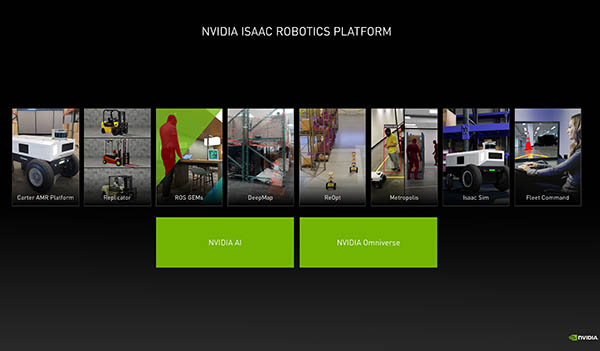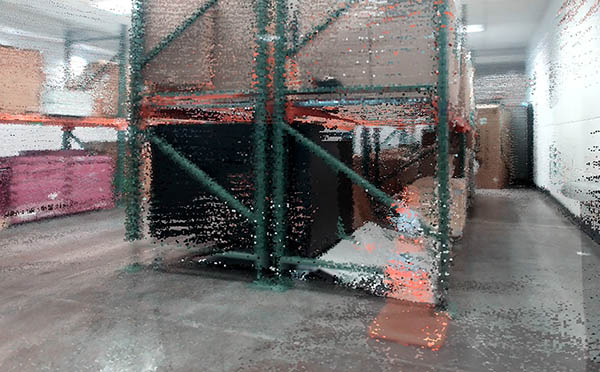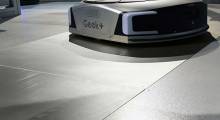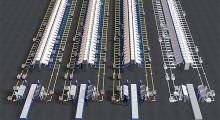Factories and fulfillment centers are huge, complex, and constantly changing. Whenever a new vehicle rolls off an assembly line or an e-commerce order arrives within hours, robots and artificial intelligence can enable greater efficiency. NVIDIA Corp. today introduced its Isaac AMR platform, which extends the company's toolkit for building and deploying robotics applications, bringing mapping, site analytics, and fleet optimization onto NVIDIA EGX servers.
“Isaac AMR is built on NVIDIA AI and Isaac Sim on Omniverse and is deployed with Fleet Command,” said Richard Kerris, vice president of Omniverse at NVIDIA.
Omniverse is the Santa Clara, Calif.-based company's scalable reference development platform using multiple graphics processing units (GPUs) for 3D simulation and collaborative design.
Robot fleets to benefit from optimization
The number of sites deploying autonomous mobile robots (AMRs) will increase from 9,000 in 2020 to 53,000 by 2025, estimated Interact Analysis. At the same time, supply chains have strained to keep up with accelerated e-commerce demand amid worker shortages and COVID-19 restrictions, said NVIDIA.
The AI and computing challenges of AMRs are similar to those of autonomous vehicles, according to the company. In industrial facilities, robots “travel miles of aisles to roll up millions of products to assist teams of moving people,” it said. “Obstacles are ever-present.”
As manufacturing centers and warehouses are reconfigured or scaled up to meet changing demand, the path planning and re-routing of AMRs must be tightly coordinated, said NVIDIA. “At industrial scale, even small routing optimizations can save billions of dollars in the $10 trillion logistics industry,” the company noted.
“One hurdle is the ability to rapidly and autonomously develop high-accuracy robot maps,” the company said. “They need to be continuously updated as operations scale or fluctuate. And increasing situational awareness of changing environments for mobile robots and continuously reoptimizing the routes — all while developing new skill sets through simulation — is paramount to operational efficiency.”
Thousands of sensors on AMRs and in facilities driven by GPU-accelerated algorithms can help robot fleets solve the “traveling salesman problem” — finding the shortest path between multiple destinations — among ever-changing industrial workflows in real time, NVIDIA claimed.
Isaac AMR built on NVIDIA Omniverse
NVIDIA said that Isaac AMR is the result of years of research and development. The framework is available on the NVIDIA NGC software hub and within NVIDIA Omniverse and will include mapping, perception, and fleet managment capabilities.
The Isaac AMR platform uses NVIDIA Omniverse to create digital twins of a facility where robots will be deployed. NVIDIA Isaac Sim on Omniverse simulates the behavior of robot fleets, people, and other machines in photorealistic, physics-accurate virtual environments for developing, testing, and managing robots. It also enables synthetic data generation for training of AI models.
Isaac AMR consists of GPU-accelerated AI technologies and software development kits (SDKs) including DeepMap, ReOpt, and Metropolis. These technologies are securely orchestrated and delivered via the cloud with NVIDIA Fleet Command.

DeepMap brings AV mapping to AMRs
NVIDIA said its acquisition of DeepMap last year brings advances in mapping for autonomous vehicles (AVs) to mobile robots. The company's Drive Sim product is designed for self-driving vehicles.
“DeepMap solves three challenges: understanding the layout, keeping maps up to date, and adding semantic understanding,” said Kerris.
“AMR deployments can access the DeepMap platform’s cloud-based SDK to help accelerate robot mapping of large facilities from weeks to days, while achieving centimeter-level accuracy,” added NVIDIA. “The DeepMap Update Client allows robot maps to be updated as frequently as necessary, in real time.”
By adding semantic understanding to maps, the DeepMap SDK enables robots to identify objects based on representative pixels and to know where to navigate, the companys said. It can be used for building maps both indoors and outdoors.
NVIDIA Metropolis offers situational awareness
Mapping doesn’t account for everything in industrial environments, and the sensors onboard AMRs aren’t always sufficient to ensure safe and efficient operation, the company said.
NVIDIA Metropolis is intended to meet the need for higher-level, real-time, “outside-in” perception. “It uses cameras and sensors deployed all over the factory or warehouse floor,” Kerris said.
With the situational awareness provided by Metropolis, AMRs can avoid high-congestion areas, said NVIDIA. The video analytics platform is designed to eliminate blind spots and enhance visibility of both people and other AMRs.
Metropolis’s pre-trained models can give robotics developers and integrators a head start in customizing deployments for site-specific needs, added NVIDIA.
ReOpt libraries designed to optimize logistics
The NVIDIA ReOpt AI software libraries can be used to optimize vehicle route planning and logistics. This is applicable to fleets of AMRs, said NVIDIA.
Operators of large, complex environments need to consider many factors when determining the best AMR fleet size, noted the company. They include robot speeds, battery life, payload size and weight, and the facility layout.
“With ReOpt's real-time route optimization, users can increase operational efficiency,” said Kerris.
Companies can use Isaac Sim with NVIDIA ReOpt to simulate multiple AMR interactions. These can happen quickly and accurately in digital twins of environments such as warehouses.
NVIDIA noted that ReOpt allows for dynamic route optimization before robots are deployed in production or in response to changing situations, saving time and money. It can also provide for re-optimization of heterogeneous AMR fleets based on a number of constraints.
NVIDIA releases Omniverse for developers
“Available on NVIDIA EGX servers, the Isaac AMR platform enhances the development of AI-driven logistics by providing a complete path to build industrial and human-robot simulations as well as route optimizations,” said NVIDIA.
Also around CES 2022, NVIDIA announced Virtual Worlds for 3D digital twins to be used in industrial design, entertainment, content creation, and communications. “More content will be made and consumed in digital worlds than in the physical world,” Kerris said.
He cited the example of the “factory of the future” at BMW, which realized 30% in savings from simulating and managing its production environment as it makes 2 million cars per year. In another example, a telecommunications provider used Omniverse Enterprise to model 5G coverage, Kerris said.
NVIDIA's Project Tokkio is a platform for trainable avatars, and its Drive Concierge is an in-car virtual assistant. The company also announced NVIDIA Omniverse Studio for 3D design and Audio2Face, particularly for video games. Kerris described USD as the “HTML of 3D” and said NVIDIA is adding connectors.
“Seven hundred companies worked with Omniverse in the early access program since GTC [NVIDIA's 2020 GPU Technology Conference], with 100,000 in open beta,” Kerris said. “Omniverse is moving out of beta and is available to GeForce RTX Studio. Free Omniverse-ready assets are available from global 3D marketplaces.”
About the Author
Follow Robotics 24/7 on Linkedin
Article topics
Email Sign Up

















